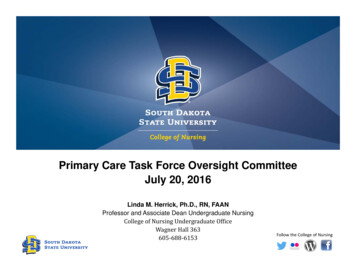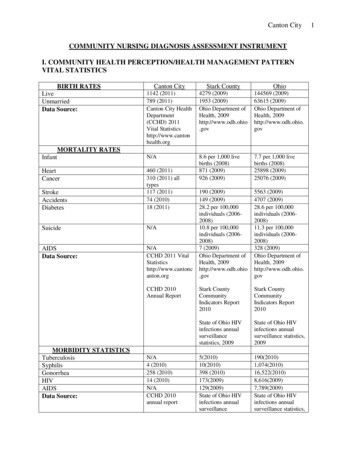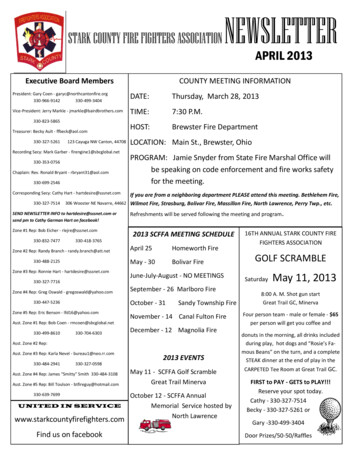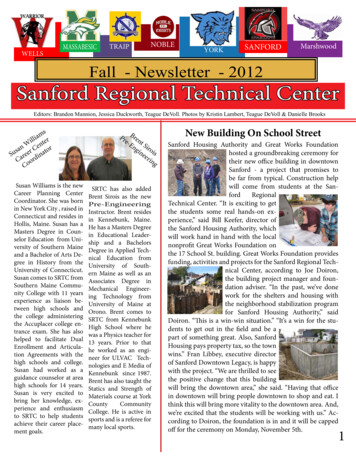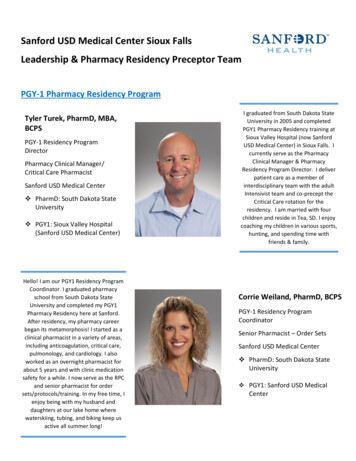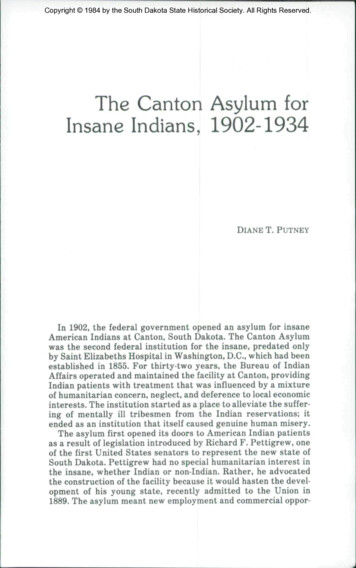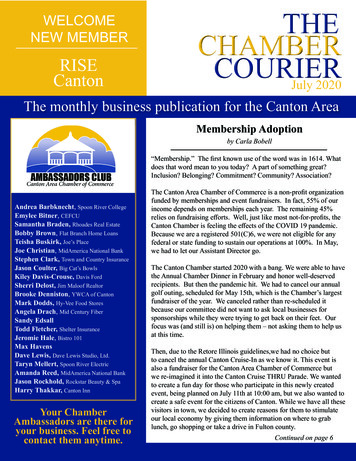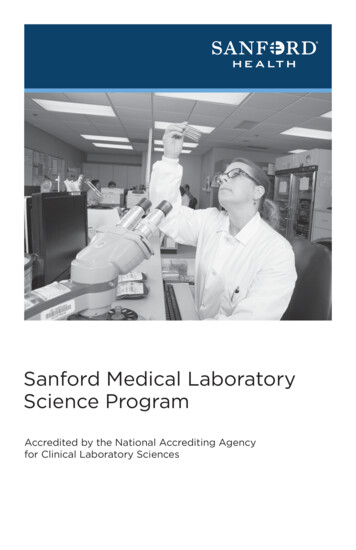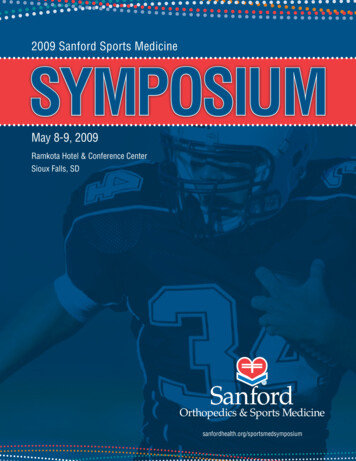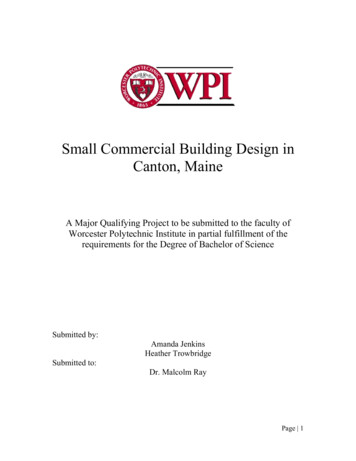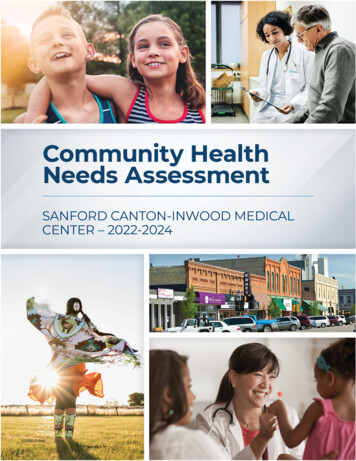
Transcription
SANFORD CANTON-INWOOD MEDICALCENTER – 2022-2024
Dear Community Members,Sanford Canton-Inwood Medical Center is pleased to present the 2022 Community Health NeedsAssessment (CHNA). Sanford Health completes a community health needs assessment everythree years. The assessment helps identify unmet health needs in the community, and allows usto strategically plan how to best address those needs. This process is well aligned with Sanford’svision to improve the human condition.From December 2020 to February 2021, members of the community were invited to complete asurvey to help identify unmet health needs across of range of social determinants of health.These include economic well-being, transportation, children and youth, the aging population,safety, access to services, and mental and behavioral health.Sanford Health and the NDSU Center for Social Research partnered to analyze data from theprimary survey research, along with key secondary data points from County Health Rankings.Sanford also facilitated discussions with key stakeholders in the community to help prioritize theidentified health needs.After completing this year’s assessment, our facility will address the following health needs in aformalized implementation strategy for the 2022-2024 time period:1.2.Access to affordable housingAccess to senior livingThe CHNA process also highlights the many strengths, support, and resources available toresidents of our community. This report includes an overview of the community assets that areoffered to address various community health needs. Additionally, we have included an impactreport detailing progress made to date with our 2019 implementation strategies.Our entire team is truly grateful to the community members who participated in this year’sassessment process. We appreciate your commitment to the health and wellness of ourcommunity. We look forward to working collaboratively with community partners andstakeholders to continue to improve the quality of life for all.Sincerely,Scott LarsonSenior DirectorSanford Canton-Inwood Medical Center2dba Sanford Canton-Inwood Medical Center EIN# 46-0388596
BACKGROUNDCommunity DescriptionSanford Canton-Inwood Medical Center is located in Canton, SD. Canton has a population of3,500, and is located 10 miles east of Interstate 29 on US Highway 18. The community issurrounded by Newton Hills State Park, Big Sioux River, and the rolling hills of the Sioux Valley.Canton is the county seat of Lincoln County.The earliest known visitor was Lewis P. Hyde, who first came to the area in 1866. By 1868, therewere 35 people living in Lincoln County. Residents named the community Canton, believing thelocation to be the exact opposite of Canton, China. In 1880, the Chicago, Milwaukee, St. Paul andPacific Railroad crossed the Big Sioux River to reach Canton. The city still has an active rail freightservice and many historic homes and buildings dating back to the late 1800s. Two of Canton’shistorical sites are the Lincoln County Courthouse built in 1889 and the Canton Lutheran Church,which was built in 1908.Canton is home to several industries: Eastern Farmers Co-op, Adams Thermal Systems, Bid-Well,a Terex Company, Johnson Feed, Inc., Fastek Products, and Legacy Electronics. The communityhas a variety of restaurants and approximately 200 total businesses.The community as defined for purposes of the Community Health Needs Assessment includesLincoln County, South Dakota, and Lyon County, Iowa. Demographic detail for the counties isincluded in the appendix.PartnersThe Community Health Needs Assessment is the result of the hard work and coordination ofnumerous people within the organization and among community partners. Sanford Healthwould like to thank and acknowledge the following for their assistance. The development of theprogram would not have been possible without their expertise regarding the communities andpopulations we serve.Sanford Health Michelle Micka, System Vice President, Finance, Health Services Dr. Jeremy Cauwels, System Vice President, Chief Physician Corey Brown, System Vice President, Government Affairs Clarence Mellang, Senior Director, Communications Michelle Bruhn, Senior Vice President, Health Services Operations Blayne Hagen, Executive Director, Legal Stacy Wrightsman, Executive Director, Community Relations Matt Ditmanson, Director, Community Benefit Programs Emily Griese, Vice President, Population Health and Clinical Operations Marnie Walth, Senior Legislative Affairs Specialist Joseph Beaudreau, Patient Relations Specialist and Indian Health Advocate Phil Clark, Director, Market Research Shawn Tronier, Senior Marketing Analyst Amber Langner, Vice President, Treasury Catherine Bernard, Director, Tax Deana Caron, Senior Tax Accountant3dba Sanford Canton-Inwood Medical Center EIN# 46-0388596
System PartnersWe would also like to express our gratitude to the following individuals for their expertise duringthe development and analysis of the Community Health Needs Assessment: Jeanne Larson, Executive Director, Northern Dental Access Center Carol Biren, Division Director, Southwest Health and Human Services Cynthia Borgen, Director, Beltrami County Public Health Mary Michaels, Public Health Prevention Coordinator, Sioux Falls Department of Health Renae Moch, Director, Burleigh Public Health and President, North Dakota Public HealthAssociation Jennifer Nelson, Public Health Educator, Southwest Health and Human Services Julie Ward, Vice President of Strategy and Social Innovation, Avera Health Jody Lien, Director, Ottertail Public Health Karen Pifher, Community Health Program Manager, Essentia Health Lori Jensen, Public Health Nurse Beltram County Health and Human Services Erica Solseth, CHI St. Alexius Health Sister Nancy Miller, Director Mission Integration, CHI St. Alexius Health Nancy Hodur, Director, North Dakota State University Center for Social Research Karen Olson, Research Specialist, North Dakota State University Center for SocialResearch Ann Kinney, Senior Research Scientist, Minnesota Department of HealthCanton-Inwood PartnersWe express our gratitude to the following community collaborative members for theirparticipation in the community stakeholder meetings: Scott Larson, Senior Director, Sanford Canton-Inwood Matt Ditmanson, Director of Community Benefits, Sanford Health Dr. Dan Heinemann, Retired Physician & CMO, Sanford Health, current communitymember, Canton-Inwood Sterling Heath, Board of Directors, Canton-Inwood Area Health Foundation Glennie Wiltgen, Board of Directors, Canton-Inwood Area Health Foundation Dawn Creech, Sales Representative, Sanford Health Jonathan Toso, Optometrist, Canton Family Vision Clinic Russ Townsend, Superintendent, Canton-Inwood, School District Terry Majerers, Associate Maintenance Mechanic, Good Samaritan Jean Fossum, Administrative Assistant, Sanford Canton-Inwood Robert Bogue, Clinical Supervisor, Keystone Treatment CenterSanford Canton-Inwood DescriptionSanford Canton-Inwood Medical Center is an 11-bed Critical Access Hospital located in abeautiful rural setting just east of Canton, South Dakota. Through a partnership of CantonInwood Memorial Hospital Association and Sanford, the community established a healthcarefacility focused on providing quality healthcare close to home.Sanford Canton-Inwood employs five clinicians, including physicians and advanced practiceproviders in the areas of family medicine, sports medicine, surgery, counseling, andinterventional cardiology and has over 100 employees.4dba Sanford Canton-Inwood Medical Center EIN# 46-0388596
CHNA PurposeThe purpose of a community health needs assessment is to develop a global view of thepopulation's health and the prevalence of disease and health issues within our community.Findings from the assessment serve as a catalyst to align expertise and develop a CommunityInvestment/Community Benefit plan of action. There is great intrinsic value in a communityhealth needs assessment when it serves to validate and justify the not-for-profit status andcreate opportunity to identify and address public health issues from a broad perspective. Acommunity health needs assessment identifies the community’s strengths and areas forimprovement. A community health needs assessment is critical to a vital CommunityInvestment/Community Benefit Program that builds on community assets, promotescollaboration, improves community health, and promotes innovation and research. Acommunity health needs assessment also serves to validate progress made towardorganizational strategies and provides further evidence for retaining our not-for-profit status.Regulatory RequirementsFederal regulations stipulate that non-profit medical centers conduct a community health needsassessment at least once every three years and prioritize the needs for the purpose ofimplementation strategy development and submission in accordance with the Internal RevenueCode 501(r)(3).The Internal Revenue Code 501(r)(3) requires that each hospital must have: (1) conducted acommunity health needs assessment in the applicable taxable year; (2) adopted animplementation strategy for meeting the community health needs identified in the assessment;and (3) created transparency by making the information widely available.The regulations stipulate that each medical center take into account input from persons whorepresent the broad interests of the community. Hospitals are required to seek at least one state,local, tribal or regional government public health department or state Office of Rural Health withknowledge, information or expertise relevant to the health needs of the community.Non-profit hospitals are required to seek input from members of medically underserved, lowincome, and minority populations in the community, or organizations serving or representingthe interest of such populations, and underserved populations experiencing disparities or at riskof not receiving adequate care as a result of being uninsured or due to geographic, language orfinancial or other barriers.The community health needs assessment includes a process to identify community resourcesthat are available to address the assessed needs and to prioritize the needs.Hospitals are to address each assessed need or explain why they are not addressing the needs.Once the needs have been identified and prioritized, hospitals are required to develop animplementation strategy to address the top needs. The strategies are reported on the IRS 990and a status report must be provided each year on IRS form 990 Schedule H.Finally, hospitals are to be transparent with the findings and make the written CHNA reportavailable to anyone who asks for the report. Sanford places the CHNA reports and theimplementation strategies on the Sanford website. Hospitals are required to keep three cycles ofassessments on the web site. The 2022 report will be Sanford’s fourth report cycle since therequirements were enacted in 2010.Sanford extended a good faith effort to engage all of the aforementioned communityrepresentatives in the survey process. We worked closely with public health experts throughoutthe assessment. Public comments and responses to the community health needs assessment5dba Sanford Canton-Inwood Medical Center EIN# 46-0388596
and the implementation strategies are welcome on the Sanford website or contact can be madeat th-needs-assessment. No communitycomments or questions regarding the previous CHNA have been made via the website link oremail address.CHNA ProcessSanford Health, in coordination with public health experts, community leaders, and other healthcare providers, within the local community and across Sanford’s care delivery footprint,developed a multi-faceted assessment program designed to establish multiple pathways forhealth needs assessment.Consultation withPublic Health,CommunityLeaders, OtherHealth SystemsCommunity mmunityStakeholderMeetingsCommunityHealth NeedsIdentifiedImplementationPlanLimitationsThe findings in this study provide an overall snapshot of behaviors, attitudes, and perceptions ofresidents living in the community. A good faith effort was made to secure input from a broadbase of the community. However, gaps in individual data sources may arise when comparingcertain demographic characteristics (i.e., age, gender, income, minority status) with the currentpopulation estimates. For example, these gaps may occur due to the difficulty in contactingthem through the survey process.To mitigate limitations, the CHNA evaluates community health from several perspectives; astakeholder and community survey, meetings with community leaders that have specialknowledge and expertise regarding populations, secondary data sources such as the U.S. CensusBureau and County Health Rankings, public comments from previous assessments, andinstitutional knowledge by Sanford employees locally and across the Sanford enterprise.Community and Stakeholder SurveyMembers of the community were asked a series of questions through an online survey designedin partnership with health experts and public health officials across the Sanford footprint tounderstand the needs of the community based upon the UW Population Health model. Eachrespondent was asked to rate community drivers from poor to excellent. Any response otherthan excellent was offered a follow up opportunity to comment on the reason. Respondentswere also asked a series of questions specific to their health care access, health care quality,barriers to care, travel to care, and insurance. The survey was sent to a sample of the Lyon County,IA and Lincoln County, SD populations secured through Qualtrics, a qualified vendor. The full setof questions is available in the appendix.To further promote community involvement the survey was also sent to communitystakeholders and elected officials with knowledge and connections amongst medicallyunderserved, low income, or minority populations. Stakeholders were asked to complete theinstrument as a resident of the community and forward the survey to their respectivepopulations for greater involvement. The survey was highlighted in a Sanford Health News ealth-needs-assessment-survey/) and promotedthrough social media via paid communications. The paid communications yielded 344,300impressions and 1,150 completed surveys across the system.Survey data for the local community should be considered directional and best utilized inconjunction with additional data. A total of 293 of respondents from the CHNA area completedthe survey. 6,748 total respondents from across the Sanford footprint completed the survey.6dba Sanford Canton-Inwood Medical Center EIN# 46-0388596
Secondary DataCounty Health Rankings is based upon theUW Population Health model and serves asthe main secondary data source utilized forthe community health needs assessment.Alignment of the survey and secondary datawithin the UW Population Health modelallows for greater connection of the data sets.Population data are sourced to the U.S.Census Bureau. Additional data sources maybe used and are sourced within thedocument.Health Needs Identification MethodologyThe Center for Social Research at NorthDakota State University was retained todevelop the initial community health needs list for each community and builds upon theirinvolvement during the previous cycle. The following methodology was used to develop thesignificant health needs presented later in the report: Survey data was stratified into representative groups based upon population: large urbancommunities, medium sized communities, and rural communities. The three groupswere analyzed separately. Canton-Inwood was included with Bagley, MN; Canby, MN;Chamberlain, SD; Clear Lake, SD; Hillsboro-Mayville, ND; Jackson, MN; Luverne, MN;Sheldon, IA; Tracy, MN; Webster, SD; Westbrook, MN; and Wheaton, MN. To identify community health care needs, each community’s score by question wascompared to the average stratified composite of the comparative group. For example, ifthe composite stratified system-wide average score is 4 and an individual community’saverage response was 2.5 that would suggest an issue of concern and a potentialcommunity health care need to be highlighted in the summary findings. Upon determination of a potential strength or need, County Health Rankings(https://www.countyhealthrankings.org/) and responses from open-ended questionsprovided additional insights into the drivers of the respective needs. A similar methodology was also used to provide additional insights into findings fromCounty Health Rankings data with relevant health needs highlighted in the surveyfindings. Health needs identified through either the survey or County Health Rankings data butnot both were also included in the findings.Community Asset MappingAsset mapping was conducted to find the community resources available to address theassessed needs. Each unmet need was researched to determine what resources were availableto address the needs. Once gaps were determined, the prioritization exercise followed with keystakeholder groups determining the top needs.Community Stakeholder MeetingsCommunity stakeholders were invited to attend a presentation of the findings of the CHNAassessment. Facilitated discussion commenced and each participant was asked to consider theneeds identified that should be further developed into implementation strategies. Health needsidentified during the previous cycle but not raised through the survey or County Health Rankingswere also considered. The meeting served to inform the group of the findings but also served asa catalyst to drive collaboration.7dba Sanford Canton-Inwood Medical Center EIN# 46-0388596
The facilitated discussion sought to inform on several aspects: What are the biggest challenges currently with these needs in the community? Does the community have gaps in services, access, outreach, etc.? Opportunities – where can we have greatest impact in addressing these needs? Which are most urgent in nature? Is there any work being done on these needs? What are the resources currently not utilized within the community that could addressthis topic? Which fall within the purview of healthcare system and which do not? Can the nonhealthcare needs be shared with other entities or organizations? Is there anything you consider an urgent need that we have not discussed?Two health needs were identified by consensus during the meeting for inclusion in theimplementation plan. The needs were confirmed with participants prior to the meeting’sconclusion. Consensus was based upon all factors, including primary and secondary data, inputfrom the community stakeholder meeting, and scalability of current hospital programs andresources to address the identified needs efficiently and effectively. All identified needs notaddressed in the implementation plan were shared with other community partners for action.Requests for survey data and other CHNA assets by public health organizations, governmentalbodies, and community partners were and continue to be supported.Community DefinitionLyon County in Iowa and Lincoln County in South Dakota are included in the data analysis andrepresents a majority of volumes to Sanford Canton-Inwood. No population was excluded fromthe process.8dba Sanford Canton-Inwood Medical Center EIN# 46-0388596
COMMUNITY HEALTH NEEDS ASSESSMENT FINDINGSCommunity Health SummaryCHNA respondents were asked to rate various community health issues and their personalhealth and wellness on the following 1 to 5 scale: 1 poor, 2 fair, 3 good, 4 very good, 5 excellent. Overall, perceptions among CHNA respondents in the Canton-Inwood area regardingthe following community health issues were positive. Average scores were as follows: Transportation (average score 3.11)Long-term nursing care and senior housing quality (average score 3.37)Employment and economic opportunities (average score 3.47)Child care and preschool quality (average score 3.59)Access to healthy foods (average score 3.73)Access to exercise opportunities (average score 3.82)Community safety (average score 3.90)Environmental health (average score 3.93)Health care quality (average score 4.05)With the exception of long-term nursing care and senior housing quality (which was lower thanthe comparison group average), average scores for CHNA respondents in the Canton-Inwoodarea for each of these community health issues were higher than the comparison group average– and in some cases (i.e., employment opportunities and health care quality), the highest amongall similar-sized market areas served by Sanford Health.When asked about their personal health, CHNA respondents in the Canton-Inwood area ratedtheir current health and wellness as good (average score 3.41) and their current ability to accesshealth care services as very good (average score 3.98); both scores were higher than thecomparison group average.County Health Rankings (CHR) data indicate that Lincoln County is ranked among the healthiestcounties in South Dakota in terms of overall health – and Lyon County is one of the healthiestcounties in Iowa. The following areas of concern were identified for further discussion (in noparticular order).Significant Health Needs IdentifiedAccess to Affordable Health CareAccess to affordable, quality health care is important to physical, social, and mental health.Health insurance, local care options, and a usual source of care help to ensure access to healthcare. Having access to care allows individuals to enter the health care system, find care easily andlocally, pay for care, and get their health needs met.When CHNA respondents in the Canton-Inwood area were asked about the most importanthealth care issues impacting their community, the cost of health care was their top concern,along with COVID-19 issues. In addition, when respondents were asked about their biggesthealth care concerns for themselves and their family (concerns they face on a regular basis), costand the ability to afford needed health care was their top health care concern. However,according to County Health Rankings (CHR), the median household income in Canton-Inwood( 76,187) is higher than the comparison group average and rates of uninsured individuals (6%),unemployment (2%), and child poverty (7%) are lower than the comparison group average.9dba Sanford Canton-Inwood Medical Center EIN# 46-0388596
Regarding routine checkups, 15 percent of CHNA respondents in the Canton-Inwood area hadnot been to a physician or provider for a routine checkup in the past year, which is lower than thecomparison group average. When asked why, the second leading concern was cost and theinability to pay for health care services (24%), behind COVID-19 concerns (48%). In addition, 10percent of CHNA respondents in the Canton-Inwood area indicated that they or a familymember needed medical care in the past year but did not receive it (which was lower than thecomparison group average). When asked why, the second and third leading concerns were thecost and inability to afford care (35%) and a lack of health insurance (35%), behind COVID-19concerns (40%).While an important issue, and one Sanford continues to address on an ongoing basis, thestakeholder meeting participants did not prioritize access to affordable care for the next 3-yearimplementation plan.Local Asset MappingMajor Employers:Money Management resources: Eastern Farmers Co-op, 415 E. 5th St., Lincoln Co. Extension Service (moneyCantonmgmt. classes), 104 N. Main St., Canton Adams Thermal Systems, 47920 W. 5th St., Farmers State Bank, 220 E. 5th St., CantonCanton Great Western Bank, 102 W. 5th St., Canton Bid-Well, 501 W. Industrial Rd., Canton First Bank & Trust, 402 E. 5th St., Canton Johnson Feed, Inc., 305 W. Industrial Rd., Security Savings Bank, 100 S. West St.,CantonCanton Fastek Products, 515 Noid St., Canton Legacy Electronics, 1220 N. Dakota St.,CantonHealth Care resources:Affordable Prescription Drugs: Sanford Canton-Inwood Medical Center & CancerCare co-payment assistance, 800Clinic, 440 N. Hiawatha Dr., Canton813-4673 Sanford Community Care Program, 440 N. Freedrugcard.usHiawatha Dr., Canton Rxfreecqrd.com Sanford Medical Home Program, 440 N. Medsavercard.comHiawatha Dr., Canton Yourrxcard.com Lincoln Co. Public Health, 104 N. Main, Medicationdiscountcard.comCanton Nedymeds.org/drugcard Sanford Home Medical Equipment, 723 E. Caprxprogram.org5th St., Canton Southdakotarxcard.com Good Samaritan Center, 1022 N. Dakota Dr., Gooddaysfromcdf.orgCanton NORD Patient Assistance Program, Keystone Treatment Center, 1010 E. 2nd St., rarediseases.orgCanton SD Partnership for Prescription Assistance, Canton Family Dental, 1110 W. 5th St.,pparx.orgCanton Patient Access Network Foundation, Swenson Chiropractic, 28199 West Ave.,panfoundation.orgCanton Pfizer RC Pathways, pfizerRX Canton Family vision Center, 109 E. 5th St.,pathways.comCanton RXhope.com Haisch Pharmacy, 303 E. 5th St., Canton Lewis Family Drug, 715 E. 5th St., Canton Lincoln Co. Community Health Nurse &WIC office, 104 N. Main St., Canton10dba Sanford Canton-Inwood Medical Center EIN# 46-0388596
Health Care for New Americans: Sanford Canton-Inwood Medical Center,440 N. Hiawatha Dr., Canton Lincoln County Community Health Nurse &WIC, 104 N. Main St., CantonAffordable Health Insurance resources: Avera Health Plans, 3816 S. Elmwood Pl.,Sioux Falls Sanford Health Plan, 1305 W. 18 St., SiouxFalls State Farm, 111 N. Main St., CantonHealth Care for Native People: SD Urban Health Clinic, 711 N. Lake Ave.,Sioux Falls American Indian Services, 817 N. Elmwood,Sioux Falls Sanford Canton Inwood, 440 N. HiawathaDr., Canton Lincoln Co. Community Health Nurse &WIC office, 104 N. Main St., CantonMental HealthMental health includes our emotional, psychological, and social well-being and affects how wethink, feel, and act. It also helps determine how we handle stress, relate to others, and makechoices. Mental health is important at every stage of life, from childhood and adolescencethrough adulthood 1.When CHNA respondents in the Canton-Inwood area were asked which health care servicesthey would like to see offered or improved in their community, most said behavioral and mentalhealth services (54%) and 25 percent said addiction treatment services. According to CountyHealth Rankings (CHR), adults in the Canton-Inwood market average 3.2 mentally unhealthydays each month and 10 percent of adults average at least 14 days of mental distress per month;however, both rates are the lowest rates among similar-sized market areas served by SanfordHealth.There are 456 people for every one mental health provider in the area, which is the lowest ratioamong similar-sized markets served by Sanford Health. Mental health emerged as one of theclear priority issues in the stakeholder meeting. Particularly, community members wereconcerned with the mental health challenges facing youth. It was also brought up that mentalhealth/behavioral health appointments, among others, are particularly difficult for people in thecommunity, taking up large portions of their day. This is because they have to travel to Sioux Fallsfor these appointments as a result of not having resources in the community. The school wasmentioned as a primary area where mental health resources are needed.Participants mentioned that telehealth would be an effective and beneficial resource to help thecommunity’s mental health. They also expressed interest in Sanford working with the localschools in a variety of ways to help the mental health of the youth. Participants also mentionedthe need to reduce the stigma of receiving mental health services, so that nobody goes withoutthe care they need. One possible solution for this issue that was mentioned was providingathletic coaches and other staff that students are comfortable with education on recognizingsigns of mental health issues.1U.S. Department of Health & Human Services, MentalHealth.gov. Available at -health11dba Sanford Canton-Inwood Medical Center EIN# 46-0388596
Local Asset MappingMental Health resources:Drug & Alcohol Use/Abuse resources: Keystone Treatment Center, 3800 S. AA, 1000 N. West Ave., Sioux FallsKiwanis Ave., Sioux Falls Arch Halfway House, 333 S. Spring Ave., Crawford Counseling Center, 500 W. 5thSioux FallsSt., Canton Avera Addiction Recovery, 2412 S Cliff Ave., SE Behavioral Health Counseling, 2000 S.Sioux FallsSummit Ave., Sioux Falls Bartels Counseling, 6330 S. Western Ave., Dakota Oak Counseling, 3200 W. 57th St.,Sioux FallsSioux Falls Carroll Institute, 310 S. First Ave., Sioux Falls Sioux Falls Psychological Services, 2109 S. Changes & Choices Recovery Center, 301 S.Norton Ave., Sioux Falls1st Avenue, Sioux Falls Great Plans Psychological Services, 4105 Choices Recovery, 2701 S. Minnesota Ave.,Carnegie Circle, Sioux FallsSioux Falls Catholic Family Services, 523 N. Duluth Face It Together, 231 S. Phillips Ave., SiouxAve., Sioux fallsFalls Heuermann Counseling Clinic, 2110 S. First Step, 4320 S. Louise Ave., Sioux FallsBrown Pl., Sioux Falls Glory House, 4000 SW Ave., Sioux Falls LifeMarks Behavioral Health, 1310 W. 51st Keystone Treatment Center, 3800 S.St., Sioux FallsKiwanis Ave., Sioux Falls NAMI South Dakota, P O Box 88808, Sioux Minnehaha Co. Detox Center, 415 N. DakotaFallsAve., Sioux Falls Stronghold Counseling Services, 4300 S. Prairie View Prevention Services, 822 E. 41stLouise Ave., Sioux FallsSt., Sioux Falls Sanford Behavioral Health, 1305 W. 18th St., Sioux Falls VA, 2501 W. 22nd St., Sioux FallsSioux FallsDrug & Alcohol Use/Abuse resourcesTobacco Cessation resources:Cont.: Sanford Canto
Sanford Canton-Inwood Medical Center is located in Canton, SD. Canton has a population of 3,500, and is located 10 miles east of Interstate 29 on US Highway 18. The community is surrounded by Newton Hills State Park, Big Sioux River, and the rolling hills of the Sioux Valley. Canton is the county seat of Lincoln County.
